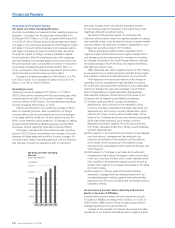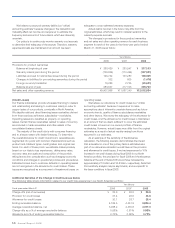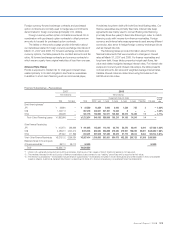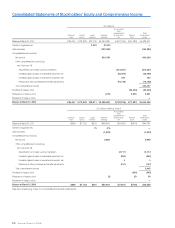Honda 2008 Annual Report Download - page 59
Download and view the complete annual report
Please find page 59 of the 2008 Honda annual report below. You can navigate through the pages in the report by either clicking on the pages listed below, or by using the keyword search tool below to find specific information within the annual report.
A n n u a l R e p o r t 2 0 0 8 5 7
Fiscal Year 2008 Compared with Fiscal Year 2007
The provision for credit losses increased by ¥19.3 billion, or 75%
primarily as a result of the weakening U.S. economy brought
upon by the subprime mortgage crisis. The weakening economy
has negatively affected certain customers’ ability to pay their
contractual obligations. Net charge-offs in our North American
portfolio increased by ¥13.7 billion, or 52%. The increase in
charge-offs was experienced primarily in the lower range of
credit quality customers. The Company has focused collection
efforts to minimize the losses on delinquent and defaulted
contracts.
The allowance for credit losses decreased by ¥0.3 billion,
or 1%, despite the reflection of the higher estimated losses
incurred as of March 31, 2008 in the North American portfolio.
The decrease was primarily due to the effect of exchange rate
changes on the allowance for credit losses.
(Losses on Lease Residual Values)
End-customers of leased vehicles typically have an option
to buy the leased vehicle for the contractual residual value of
the vehicle or to return the vehicle to our finance subsidiaries
through the dealer at the end of the lease term. Likewise, dealers
have the option to buy the vehicle returned by the customer or
to return the vehicle to our finance subsidiaries. The likelihood
that the leased vehicle will be purchased varies depending on
the difference between the actual market value of the vehicle at
the end of the lease term and the contractual value determined
at the inception of the lease. Our finance subsidiaries in North
America have historically accounted for all leases as direct
financing leases. However, starting in the year ended March
31, 2007, some of the leases which do not qualify for direct
financing leases accounting treatment are accounted for as
operating leases.
We initially determine the contract residual values by
using our estimate of future used vehicle values, taking into
consideration data obtained from third parties. We are exposed
to risk of loss on the disposition of returned lease vehicles when
the proceeds from the sale of the vehicles are less than the
contractual residual values at the end of the lease term. We
periodically review the estimate of residual values. Downward
adjustments are made for declines in estimated residual
values that are deemed to be other-than-temporary. For direct
financing leases, our finance subsidiaries in North America
purchase insurance to cover a portion of the estimated residual
value. The adjustments on the uninsured portion of the vehicle’
residual value are recognized as a loss in the period in which the
estimate changed.
For vehicle leases accounted for as operating leases, the
adjustments to estimated residual values result in changes to the
remaining depreciation expense to be recognized prospectively
on a straight-line basis over the remaining term of the lease.
The primary components in estimating losses on lease
residual values are the expected frequency of returns, or the
percentage of leased vehicles we expect to be returned by
customers at the end of the lease term, and the expected loss
severity, or the expected difference between the residual value
and the amount we receive through sales of returned vehicles
plus proceeds from insurance, if any. We estimate losses on
lease residual values by evaluating several different factors,
including trends in historical and projected used vehicle values
and general economic measures.
We believe that our estimated losses on lease residual
values is a “critical accounting estimate” because it is highly
susceptible to market volatility and requires us to make
assumptions about future economic trends and lease residual
values, which are inherently uncertain. We believe that the
assumptions used are appropriate. However actual losses
incurred may differ from original estimates.
If future auction values for all Honda and Acura vehicles in
our North American direct financing lease portfolio as of March
31, 2008, were to decrease by approximately ¥10,000 per
unit from our present estimates, the total impact would be an
increase in losses on lease residual values by approximately
¥0.7 billion. Similarly, if future return rates for our existing
portfolio of all Honda and Acura vehicles were to increase by
one percentage point from our present estimates, the total
impact would be an increase in losses on lease residual values
by approximately ¥0.1 billion. With the same prerequisites
shown above, the impacts to the operating lease portfolio would
be approximately ¥0.5 billion and ¥0.07 billion, which would
be recognized over the remaining lease terms. Note that this
sensitivity analysis may be asymmetric, and are specific to the
base conditions in fiscal 2008.
(Pension and Other Postretirement Benefits)
We have various pension plans covering substantially all of
our employees in Japan and certain employees in foreign
countries. Benefit obligations and pension costs are based on
assumptions of many factors, including the discount rate, the
rate of salary increase and the expected long-term rate of return
on plan assets. The discount rate is determined mainly based
on the rates of high quality corporate bonds or governmental
bonds currently available and expected to be available during
the period to maturity of the defined benefit pension plans.
The salary increase assumptions reflect our actual experience
as well as near-term outlook. The expected long-term rate of
return is determined based on the expected long-term return
of the various asset categories. Honda considers the current
expectations for future returns and the actual historical returns of
each plan asset category. Our assumed discount rate and rate
of salary increase as of March 31, 2008 were 2.0% and 2.3%,
respectively, and our assumed expected long-term rate of return
for the year ended March 31, 2008 was 4.0% for Japanese
plans. Our assumed discount rate and rate of salary increase as
of March 31, 2008 were 5.5-6.8% and 2.9-6.4%, respectively,
and our assumed expected long-term rate of return for fiscal
2008 was 6.5-8.3% for foreign plans.
We believe that the accounting estimates related to our
pension plans is “critical accounting estimate” because changes
in these estimates can materially affect our financial condition
and results of operations.
Actual results may differ from our assumptions, and the
difference is accumulated and amortized over future periods.
Therefore, the difference will be generally reflected as our
recognized expenses and recorded obligations in future
period. We believe that the assumptions currently used are
appropriate, however, differences in actual expenses or changes
in assumptions could affect our pension costs and obligations,
including our cash requirements to fund such obligations.
The following table shows the effect of a 0.5% change in the
assumed discount rate and the expected long term rate of return
on our funded status, equity, and pension expense.
























